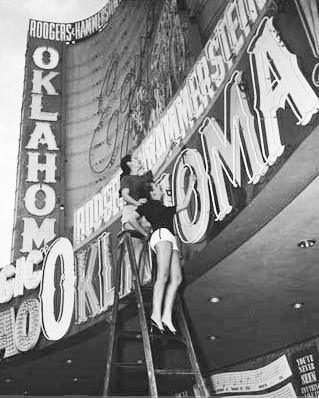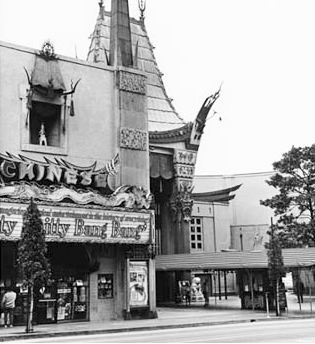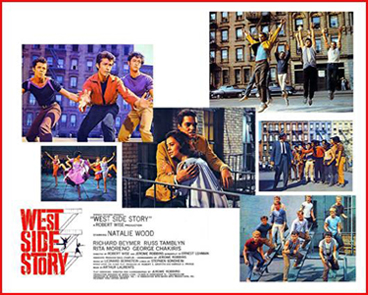INTRODUCING
THE ROADSHOW ERA
The bygone era of Roadshow engagements is probably the best example of first-class movie showmanship, for the way movies were booked, advertised, sold, and PRESENTED.
The term Roadshow most likely recalls the touring company of a theatrical stage show. A select few motion pictures were first presented this way, given all the prestige and exclusivity of a live performance. A Roadshow movie would open only in the best theatres in the largest cities, sometimes playing there for a year or more, before the picture found its way to neighborhood movie houses.
Many people attribute the creation of a roadshow exhibition policy to Michael Todd, (THIS IS CINERAMA) or David O. Selznick, (GONE WITH THE WIND) but the idea of presenting a film as a theatrical event goes back to what seems to be the first feature length (silent) motion picture ever shown in a proper theatre. Sarah Bernhardt was filmed in a French stage play as QUEEN ELIZABETH, and the film was imported to the USA. It opened July 12, 1912 at the Lyceum, a legitimate theatre on West 45th Street, just East of Broadway. The unprecedented four reel length picture was shown in four acts, closing the curtains for an intermission at every reel change. It was a commercial and critical success.
As two of his four roadshow features were being prepared for laserdisc, legendary film director Robert Wise recalled that he had been taken as a child to see the silent version of THE TEN COMMANDMENTS, for which reserved seats were sold well in advance, and a live orchestra accompanied the film. He remembered it being an event like a roadshow.
Whatever its origin, Roadshow presentation seemed to become popular in the fifties, and hit its peak in the sixties, before dying out in the early seventies. For a while, studios loved the idea, because being a roadshow elevated a picture's status, stretched out its release, and brought in a lot more money while building up anticipation and word-of-mouth before finally arriving at the neighborhood theatres.
Reserved-seat tickets were sold far in advance, for a limited number of showings a week, usually once a night, with matinees on Saturday, Sunday and Holidays. Larger cities might add a weekday matinee, and sometimes extra shows on weekends. Often in larger cities, like New York and Los Angeles, the theatre signage for roadshow movie titles was made the same way, and just as elaborate, as the theatre's own permanent signs. The theatres would often have custom made marquee boards and lobby displays. Colorful souvenir books, and sometimes the soundtrack albums, were sold at the theatre.




Instructions were sent out with the prints, requiring that no other music be played in the theatre during the engagement, and that the lights and curtain movement be carefully timed for maximum effect (and to never show a blank screen). You can read some of those instructions on the great American Widescreen Museum site. The show typically began with an overture, music to introduce the film, played over a lighted curtain with the house lights going down. At the end of act one, an intermission title came on, and stayed up long enough for the curtains to close over it. There was a 15 minute intermission, entr'acte music to introduce the second act, and often exit music played through the closed curtain as the audience walked out.
Going to see a roadshow movie was an event, that people often planned in advance, looked forward to, and dressed up for. It was a total experience that you remembered and talked about long afterward.
Movies that were presented as a roadshow included THE SOUND OF MUSIC, MY FAIR LADY, CAMELOT, BEN-HUR, THE TEN COMMANDMENTS, LAWRENCE OF ARABIA, OKLAHOMA! AROUND THE WORLD IN 80 DAYS, IT'S A MAD, MAD, MAD, MAD WORLD, THE SAND PEBBLES, HALF A SIXPENCE, PAINT YOUR WAGON, GOODBYE, MR. CHIPS, 2001: A SPACE ODYSSEY, SOUTH PACIFIC, SPARTACUS, THOROUGHLY MODERN MILLIE, HAWAII, CHITTY CHITTY BANG BANG, DOCTOR DOLITTLE, DOCTOR ZHIVAGO, HELLO, DOLLY!, STAR!, SWEET CHARITY, OLIVER!, FIDDLER ON THE ROOF, WEST SIDE STORY, FINAN'S RAINBOW, and FUNNY GIRL...
Robert Wise had three musical roadshows, two of which had visual (onscreen) overtures, because Wise didn't want the overture music to be muffled by firing through a curtain. For WEST SIDE STORY, he had Saul Bass design a screen image that looked like a "show scrim" - the kind of painted drop an overture might play over in a live theatre, before dissolving in a light cue as the act began. Bass' design was just a few simple lines, and the background changed color several times with the changes in the music. It was only at the end of the overture that the audience finally saw what the image was. STAR! was about a life on the stage, so Wise had it begin in a theatre, as the musicians entered the orchestra pit and began tuning up for the overture. There was even a "full house" audience murmur in the surrounds.
Wise's other musical roadshow, THE SOUND OF MUSIC was to begin quietly, as little notes float in with the breeze over the mountains, so it has no overture. PAINT YOUR WAGON and HELLO, DOLLY! have somewhat similar openings, so they have no overture either. Both do have exit music.
GONE WITH THE WIND had not only an overture, entr'acte and exit music, it also had several minutes of music at the end of the first act, that was to play through the first few minutes of the intermission, as the audience walked out. The 1969 roadshow musicals SWEET CHARITY and GOODBYE, MR. CHIPS are both unique, in that CHARITY's overture bridges seamlessly into the main title credit sequence, and CHIPS' entr'acte leads right into the second act opening number. MY FAIR LADY's overture begins through the curtains, quickly transitions into onscreen shots of flowers, then into the main title sequence.
Not just music: the groundbreaking THIS IS CINERAMA used the place of the entr'acte to let Lowell Thomas narrate a demonstration of the multichannel sound system. HOW THE WEST WAS WON had vocals along with the overture, entr'acte and exit music. IT'S A MAD, MAD, MAD, MAD, WORLD added a long recording of police-radio calls during most of the intermission, so that the audience could keep tabs on what the characters were up to. CHITTY CHITTY BANG BANG is preceded by sounds of an auto race around the theatre.
Almost, but not roadshows: THE KING AND I, based on the Broadway musical, did not have an overture or intermission until a later reissue, when an overture and entr'acte were assembled from underscore music, but the intermission fell very naturally in exactly the same place it had been in the show. An intermission was being considered for MARY POPPINS, right after the song "Stay Awake" - There was even a title card made up, but the picture was released without it. DARLING LILI seems to have been planned as a roadshow - a typical Henry Mancini choral overture, and similar exit music were recorded, but not included on the picture until decades later, when the director cut out so much footage, the studio wanted to pad the running time. The last movie we can recall that had a traditional overture was THAT'S ENTERTAINMENT III, which, like the first two before it, was released as regular feature, but had an overture and exit music. The overture for TE3 was created by Marc Shaiman, who grew up loving musicals, and wrote one of the very best for that film. Some people recall the premiere engagement of THE NIGHTMARE BEFORE CHRISTMAS having an overture, which was memorable also because it precluded that theatre's usual pre-programmed curtain prologue. However, neither of its two DVDs, nor several reissues have used that music again.


Today, when a casual consumer finds one of these titles on DVD, they often don't realize how specially handled these movies were. And unfortunately, the young people in home video departments of movie studios have no idea how to handle special roadshow elements, like overtures, intermissions, entr'actes, exit music, etc., because they haven't experienced theatrical movie showmanship, and regard movies as merely software.
Today's audiences, accustomed to the generic movie supermarket nature of the modern multiplex, can't even imagine a time when a movie could be an Event, given its own real theatre, for long runs up to a year or more, with elaborate signage and displays, and classy presentation, often with far better picture and sound quality than we get today.
When these movies show up in revival screenings, they are rarely handled as carefully as they were originally, especially since most of today's cinemas lack the necessary atmosphere and equipment, (including curtains) and nearly all are lacking people who know how to handle them.
Some of us remember this time as a golden era of exceptional motion picture showmanship. This section is dedicated to preserving its memories, and enlightening later generations, about how a movie can be presented as a memorable event.
TJE
CURRENT ROADSHOW STORIES

 FUNNY GIRL - 40TH ANNIVERSARY WEST SIDE STORY - 1961
FUNNY GIRL - 40TH ANNIVERSARY WEST SIDE STORY - 1961
Discuss Roadshow films on our Message Boards
Contact us with Suggestions of Roadshow Movies to Feature
Details of Roadshow Presentation at the American Widescreen Museum

